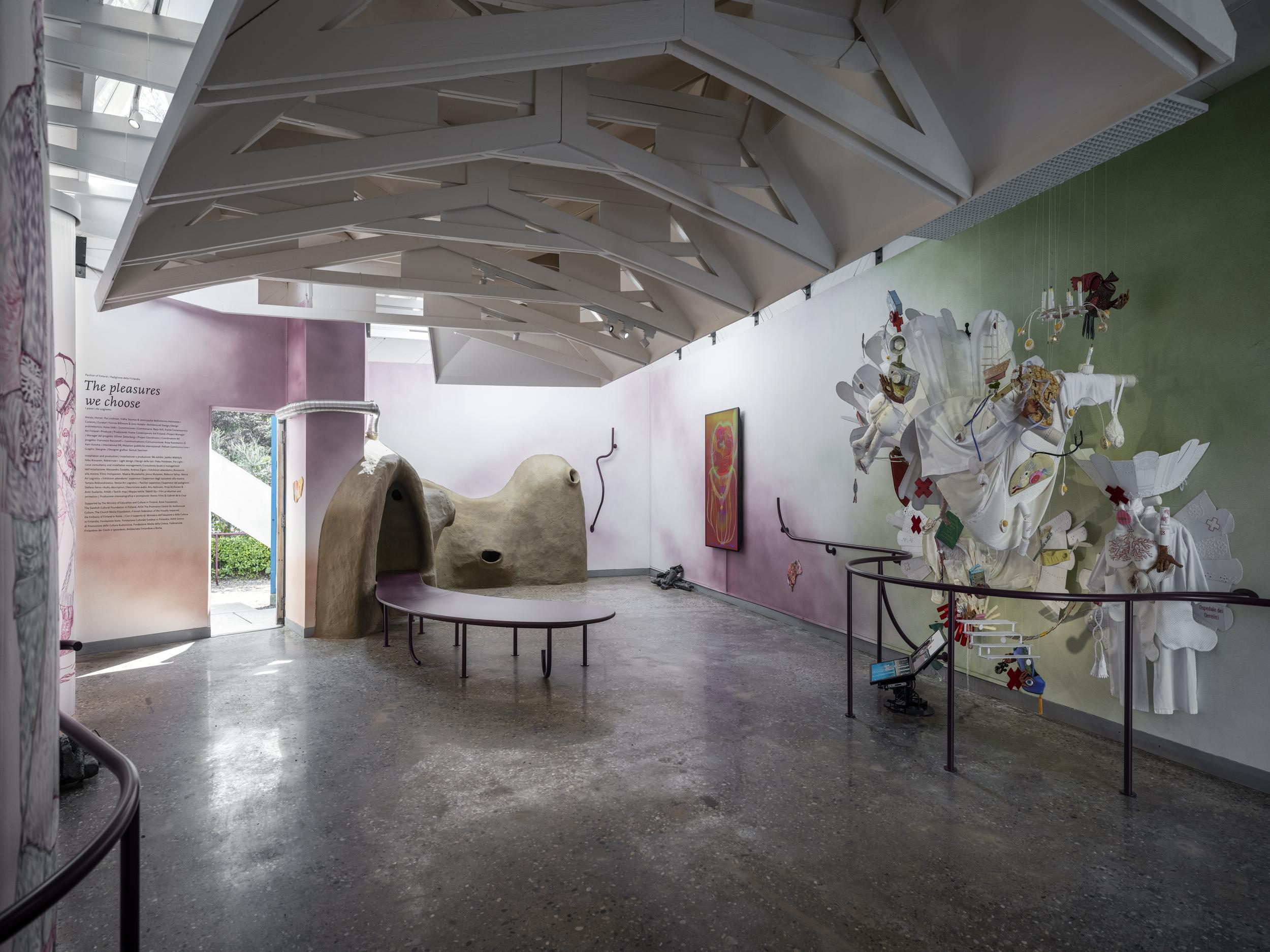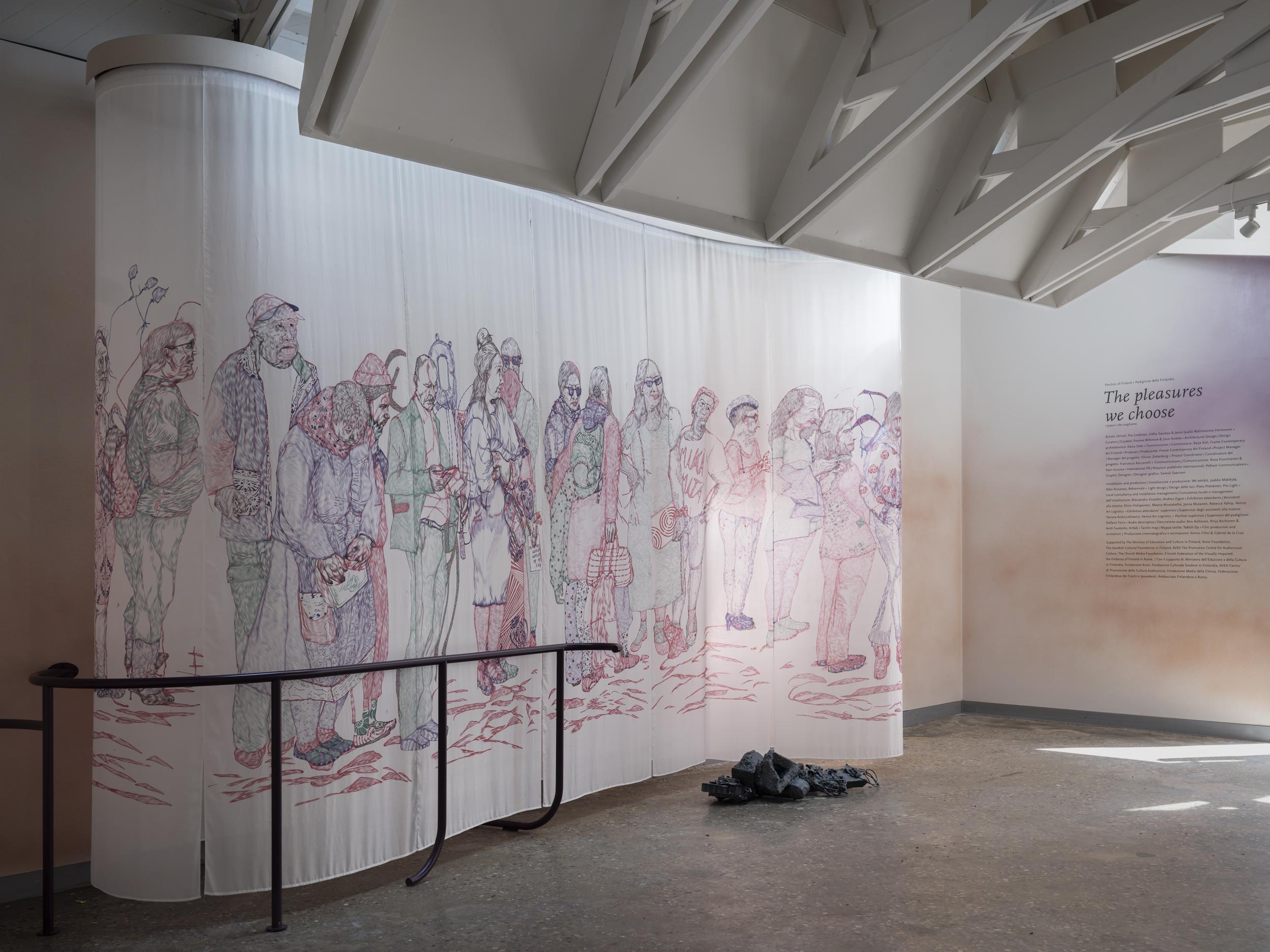
Exhibition view of The pleasures we choose, Pavilion of Finland at the 60th International Art Exhibition – La Biennale di Venezia, 2024. Photo: Ugo Carmeni / Frame Contemporary Art Finland.
The Pavilion of Finland premieres The pleasures we choose, a new multifaceted collaboration by artists Pia Lindman, Vidha Saumya, Jenni-Juulia Wallinheimo-Heimonen, curators Yvonne Billimore and Jussi Koitela, and architectural designer Kaisa Sööt. Commissioned and produced by Frame Contemporary Art Finland, the exhibition opens at the 60th International Art Exhibition – La Biennale di Venezia and speaks to the inseparability of art and life.
Blurring the boundaries between art, architecture, and social commentary, the Pavilion of Finland brings together three artists for whom art, life, and activism are intertwined. Embraced as a collective project, The pleasures we choose evolved through the exchange of shared and individual experiences to create areas of diverse ‘occupancies’ where visitors are encouraged to reassess and (re)consider societal expectations.
Pia Lindman, Vidha Saumya and Jenni-Juulia Wallinheimo-Heimonen’s practices are acutely informed by their embodied experiences of structural, environmental and social imbalances. Articulated through a wide range of materials and processes – including drawing, needlework, sculpture and healing – their works celebrate the pleasure of the personal as a powerful means of reimagining the world as we know it.
Following mercury poisoning, artist and healer Pia Lindman experiences heightened sensitivity of the nervous system and awareness of the micro-signals within her body. She translates these subsensorial signals into visual images, melodies, words, and colours and incorporates them into artworks that explore the nuances of different environments and social situations. In the exhibition, Lindman’s work Collectivities Cycle takes the form of an air-conditioning clay sculpture that exposes visitors to the sculpture’s organic matter and the microbes it supports. Accompanying “living digital paintings”—emerging from her ongoing participation in an online Tong Ren healing community—radiate with images that slowly glitch and shift into different bodily forms and energies.
Often engaging with the intricate relationship between human presence and the environment, Vidha Saumya’s works challenge the norms of aesthetics, gender, academia and nation-state. In the pavilion, Saumya’s work To all the barricades… the rumour got you is presented as a bricolage of three distinct bodies of work across drawing, sculpture and cross-stitch. Her multi-panel ballpoint pen drawing on silk cloth depicts an assembly of individuals waiting in line. Saumya explores the queue, an embodiment of time spent waiting, as an offspring of bureaucracy and trickle-down economy, and thus a universally recognised social architecture. Meanwhile, a series of sculptures mimics the insignificant debris lining the city sidewalks. Occupying the liminal space between utility and obsolescence, this ‘immortal trash’ changes form but does not perish. Lastly, a constellation of cross-stitched textiles replicate stains, patches of moisture, mold, pollutants, or toxins, questioning who and what is rendered a contaminant in our natural and social climates.
How Great is Your Darkness by Jenni-Juulia Wallinheimo-Heimonen, a multi-dimensional artwork containing a textile installation, moving wheelchair sculpture and short videos, points to the hate speech people with disabilities are subjected to—particularly from within the medical and social care industries. Across her practice as an artist and activist, Wallinheimo-Heimonen advocates for a shift from the medical model of disability, in which those with disabilities are typically “treated” to fit society, towards a social model, in which it is the ableist cultural attitudes that need to be transformed. The fantastical scenes she creates re-story people with disabilities as their own agents of transformation. Under the guise of humour, parties, pearls, and exquisite stitch work, her piece is thickly laced with references to the hate speech, guilt and stereotyping that people with disabilities are forced to endure in their everyday lives.
The artists’ works are connected conceptually and materially through architectural interventions designed by Kaisa Sööt in collaboration with the working group. Reimagining the pavilion and the kind of art, bodies and experiences it can support, the exhibition’s “access architecture” considers access and bodily needs across registers whilst encouraging new sensory experiences. These support structures materialise inside and outside of the pavilion – designed by Alvar Aalto in 1956 – from a handrail extending from the Giardini’s grounds to the access tools, spatial guides and places to rest and connect inside the pavilion. Acting as a guiding element, the thoughtful exhibition design considers different rhythms and durations of engagement.
The pleasures we choose refuses the exceptionalism of art and the myth that the artist is separate from the world, emphasising on the contrary that it is precisely the experiences which draw attention to co-existence—getting in line, taking to the streets, receiving medical care, breathing the same toxic air—that drive us towards drawing new collective futurities into existence.
The exhibition is accompanied by a publication edited by Yvonne Billimore and Jussi Koitela, published by K. Verlag and Frame Contemporary Art Finland, and designed by Samuli Saarinen. Intended as a handbook, it extends the core practices, processes, and politics of the project beyond the pavilion’s walls through various contributions. The publication is available also online as an open access PDF. There is also an audio description available about the exhibition.

Artists
Pia Lindman explores the world of the subsensorial. After being poisoned by Mercury, her nervous system became sensitized to micro-signals from within her body. These signals she transforms into images, melodies, words, and colors, allowing her to tune into atmospheres, toxicities and materiality in different spatial and social conditions. She has exhibited at the 32nd São Paulo Biennial, MoMA, MoMA PS1 and HKW in Berlin and was a fellow at Center for Advanced Visual Studies, MIT (2004–2007).
Vidha Saumya practice weaves together notions of exile and utopia, questioning the normatives of aesthetics and socio-political ecologies. Through acrid humour, haptic textures, and arduous workwomanship, her poems, drawings, photographs, videos, books, embroidery, sculptures, culinary interventions, and digital artefacts are at once accessible and intensely challenging. She is co-founder and co-editor of NO NIIN Magazine and a founding member of Museum of Impossible Forms.
Jenni-Juulia Wallinheimo-Heimonen is a multidisciplinary artist and disability activist whose work spans sculpture, video, performance and activism within disability politics and policy. Her works deal with structural violence and discrimination framed as kindness, and issues related to women with disabilities. Wallinheimo-Heimonen has facilitated social art workshops and participated in exhibitions in Finland and abroad. She received the Finnish State Prize for Multidisciplinary Art in 2019.
Curators
Yvonne Billimore’s interdisciplinary practice facilitates situations for collective learning, exchange and experiences with particular attention to the intersections of feminist and ecological practices. She is the artistic director of Bioart Society.
Jussi Koitela is Head of Programme at Frame and an independent curator. His curatorial work intertwines art, embodied research methods, urban spatial contexts, collaboration, hospitality and materiality in various forms of exhibitions and knowledge production.
Together they co-curated Rehearsing Hospitalities, Frame’s public programme from 2019 to 2023.
Exhibition Designer
Kaisa Sööt is a Tallinn-based practitioner, focussing on furniture and exhibition design. She has made exhibition designs for various museums and galleries, such as the Contemporary Art Museum of Estonia (EKKM), Estonian Art Museum (KUMU), Tartu Art Museum, Pori Art Museum and Konsthall C in Stockholm. She has also designed and built furniture for community schools in Brazil and NART community garden in Narva, and designed public playgrounds in Tallinn. Recently she has designed and been operating a public sauna Logi in Tallinn together with colleagues.
Commissioner
The exhibition in the Pavilion of Finland is commissioned and produced by Frame Contemporary Art Finland. Frame, an advocate for Finnish contemporary art, supports international initiatives, facilitates professional partnerships, and encourages critical development of the field through grants, visitor programme and residencies, seminars and talks, exhibition collaborations and network platforms.
Supporters
The pleasures we choose is supported by the Ministry of Education and Culture in Finland, Kone Foundation, The Swedish Cultural Foundation in Finland, AVEK The Promotion Centre for Audiovisual Culture, The Church Media Foundation, Finnish Federation of the Visually Impaired and the Embassy of Finland in Rome. The artists’ work has been supported by Kone Foundation, The Alfred Kordelin Foundation and The Swedish Cultural Foundation in Finland.
Exhibition Details
Pavilion of Finland at the 60th International Art Exhibition – La Biennale di Venezia
Address: Pavilion of Finland, Giardini di Castello 30122
Exhibition dates: 20 April – 24 November 2024
Press preview days: 17–18–19 April 2024
For information and requests for interviews:
International press:
Yaz Ozkan and Phoebe Heins at Pelham Communications
yaz@pelhamcommunications.com or phoebe@pelhamcommunications.com
+44 20 8969 3959
Finnish press:
Rosa Kuosmanen, Head of Communications at Frame
rosa.kuosmanen@frame-finland.fi
+358 50 465 3462
Credit Line: The Pavilion of Finland at the 60th International Art Exhibition – La Biennale di Venezia, 2024 is commissioned by Frame Contemporary Art Finland, 20 April – 24 November 2024, frame-finland.fi
